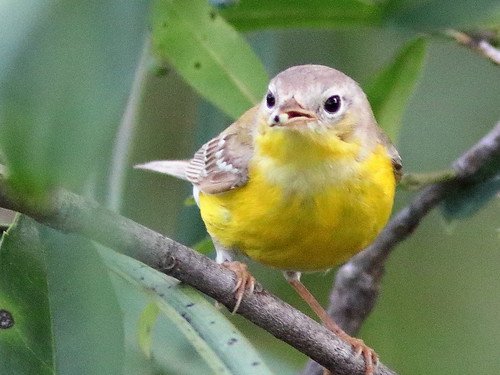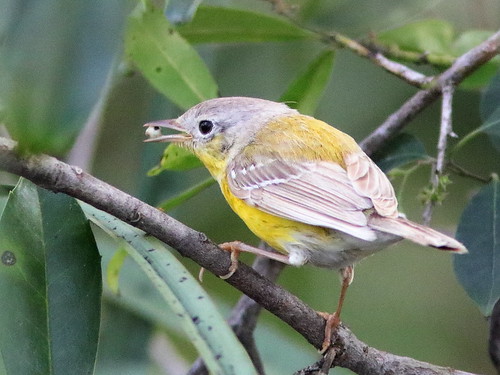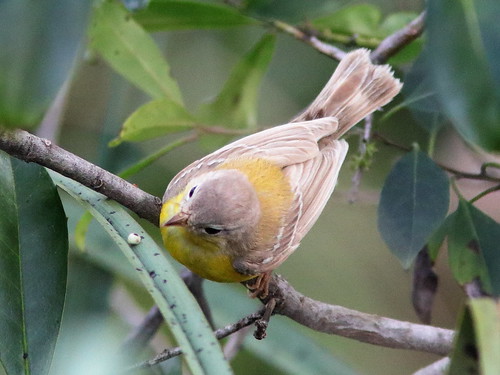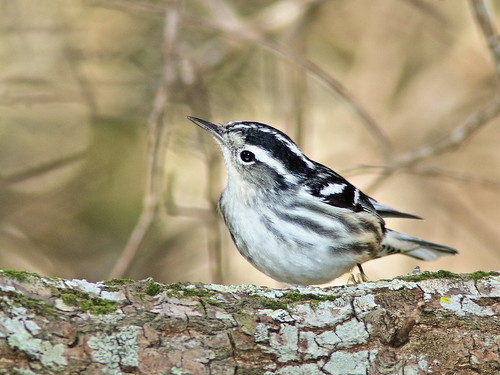Although this warbler nests far north of any Magnolia tree, it was named for the location in which it was first "discovered." American ornithologist Alexander Wilson found this species in magnolias near Fort Adams, Mississippi The adults are brightly patterned in yellow, black, blue-gray and white.
I photographed this northbound male in bold breeding colors at Nelson Lake preserve in northeastern Illinois on May 10, 2011:

Exactly eight years later, on May 10, 2019 I found this adult male in almost the same spot:

Also in Illinois, I obtained an underside view of another male back in May, 2014. Note the distinctive and unique undertail pattern with two terminal black spots:

This is a fall female (Illinois, September, 2017):

Most of the fall Magnolia Warblers we see here in Florida are first year birds. Their colors are subdued. These were present at Chapel Trail Preserve near our home during December, 2019--


In early January, while leading a nature walk at Chapel Trail I spotted an unusual Magnolia Warbler. It was a very bright yellow female, probably a first year immature bird. Its legs and bill were very pale. Its back was bright yellow without the normal dark streaking, and its head, wings and tail were light tan rather than dark gray. The spots under its tail were brown rather than black. Likewise, its eyes seemed not to be pitch black, but rather were brownish. During the following week I obtained a series of photos to document its plumage:



Although I was willing to describe this bird as having "dilute" plumage or possibly as being "leucistic," experts had a more specific name for its faded appearance. They classified it as exhibiting Type 4 oculo-cutaneous albinism. It lacks a specific black melanin pigment, but does produce other lighter melanin. A "pure" albino (Type 1A) would have no melanin and its plumage would be all white with pink eyes. Such a bird would probably not survive in the wild. This Magnolia Warbler may be relatively easy for a predator to locate and capture. (I enjoyed the thrill of discovery, but this may be more than you ever wanted to know!*)
Other warblers present at Chapel Trail were a Black-and-White Warbler...


...an Orange-crowned Warbler:

...and many Yellow-rumped Warblers:

The boardwalk at Chapel Trail Nature Preserve:

Common Gallinule reflection:

*REF: Melanins are the ubiquitous pigments distributed in nature. They are one of the main pigments responsible for colors in living cells. Birds are among the most diverse animals regarding melanin-based coloration, especially in the plumage, although they also pigment bare parts of the integument. This review is devoted to the main characteristics of bird melanins... (LINK to EVEN MORE THAN YOU EVER WANTED TO KNOW)
= = = = = = = = = = = = = = =
Linking to :
Camera Critters
Saturday's Critters
Skywatch Friday
Weekend Reflections
BirdD'Pot
Our World Tuesday
Wild Bird Wednesday
Wordless Wednesday (on Tuesday)
All Seasons
Fences Around the World
______________________________________________
Please visit the links to all these posts to see some excellent photos on display
________________________________________________
Lovely set of photos, that male Magnolia Warbler is fabulous. Have a good day, Diane
ReplyDeleteCool to see these birds all winter. We don't see much of them during the breeding season as they are quite secretive.
ReplyDeleteStunning set of bird photographs Kenneth
ReplyDeleteWarblers are so sweet. Ours are gone for now.
ReplyDeleteLike me, you want to know why something is different from what you are used to. Lovely birds, have a great day!
ReplyDeleteLovely birds and great photos!
ReplyDeleteIncredible photography! That warbler is adorable!
ReplyDeleteWonderful bird captures and I live the boardwalk shot. Have a nice weekend!
ReplyDeleteHello, wonderful post and info on the Magnolia Warbler, they are beautiful. I love all the warblers. Gorgeous photos. Nice shot of the boardwalk and pretty sky. Thank you for linking up and sharing your post. Happy Saturday, enjoy your weekend! PS, thank you for the visit and comment today.
ReplyDeleteAll of the variations make it difficult to ID them! We have so many Warblers in our area right now. We even have a beautiful Yellow throated Warbler at our feeder every day. He has bright colors! Love your photos! Happy weekend!
ReplyDeleteLovely bird photos. The reflection shot is excellent... monochrome except for the bright beak.
ReplyDeleteWhat beautiful birds! Thank you for the information about them.
ReplyDeleteI was thrilled to read about your "pale" warbler. That is why birding is so much fun.
ReplyDeleteI'm late coming to visit - couldn't connect to the internet 'til now. Thanks for linking in at IRBB thus weekend.
I like the photos and the reflection is excellent!
ReplyDeleteI enjoyed reading your post accompanied with amazing series of images.
ReplyDeleteBeautiful. Love the warbler - wish we had some here!
ReplyDeleteThanks for linking up at https://image-in-ing.blogspot.com/2020/02/cinnamon-apple-pull-apart-bread.html
The colours on the male warbler are really beautiful.
ReplyDeleteLovely photo series and I love the addition of all the information about these Warblers - you learn something new every day, and for me today, it was this!
ReplyDeleteI like all the Warbler's you have included, with the yellow on the Magnolia Warbler being so striking!
Your warblers are remarkable - even the pale ones!
ReplyDeleteCheers - Stewart M - Melbourne
Gorgeous photos of those little ones! They're not always easy to photograph.
ReplyDelete